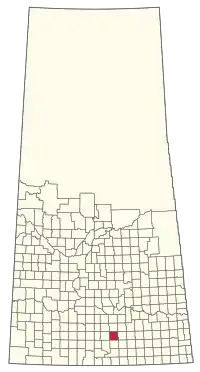Elmsthorpe No. 100 | |
|---|---|
| Rural Municipality of Elmsthorpe No. 100 | |
 Location of the RM of Elmsthorpe No. 100 in Saskatchewan | |
| Coordinates: 49°53′31″N 105°01′30″W / 49.892°N 105.025°W[1] | |
| Country | Canada |
| Province | Saskatchewan |
| Census division | 2 |
| SARM division | 2 |
| Federal riding | Moose Jaw—Lake Centre—Lanigan |
| Provincial riding | Lumsden-Morse Weyburn-Big Muddy |
| Formed[2] | December 12, 1910 |
| Government | |
| • Reeve | Ken Miller |
| • Governing body | RM of Elmsthorpe No. 100 Council |
| • Administrator | Jaimie Paranuik |
| • Office location | Avonlea |
| Area (2016)[4] | |
| • Land | 843.12 km2 (325.53 sq mi) |
| Population (2016)[4] | |
| • Total | 226 |
| • Density | 0.3/km2 (0.8/sq mi) |
| Time zone | CST |
| • Summer (DST) | CST |
| Postal code | S0H 0C0 |
| Area code(s) | 306 and 639 |
The Rural Municipality of Elmsthorpe No. 100 (2016 population: 226) is a rural municipality (RM) in the Canadian province of Saskatchewan within Census Division No. 2 and SARM Division No. 2. It is located in the southeast portion of the province.
History
The RM of Elmsthorpe No. 100 was incorporated as a rural municipality on December 12, 1910.[2]
Heritage properties
There are four historical properties located within the RM.
- Claybank Brick Plant - Constructed in 1912 - 1914, and located within Claybank the plant is now a national historic site. The plant previously operated under the name Saskatchewan Clay Products; Dominion Fire Brick and Pottery Company; Dominion Fire Brick and Clay Products Ltd.; A.P. Green Refectories Ltd.[5]
- Crystal Hill School (now called the Crystal Hill Community Centre) - Constructed in 1930 as a one-room school the building served as a school from 1930 until 1954. The building is based on a Waterman-Waterbury Company design.[6]
- Saskatchewan Wheat Pool Elevator #292 - Constructed in 1964, and located within the hamlet of Truax.[7]
- St. Joseph's Roman Catholic Church - Constructed in 1928, and located within the hamlet of Claybank.[8]
Geography
Geographical features in the RM include the Dirt Hills, Watson Reservoir, Avonlea Badlands, and Avonlea Creek.
Communities and localities
The following urban municipalities are surrounded by the RM.
The following unincorporated communities are within the RM.
- Localities
Demographics
In the 2021 Census of Population conducted by Statistics Canada, the RM of Elmsthorpe No. 100 had a population of 195 living in 92 of its 112 total private dwellings, a change of -13.7% from its 2016 population of 226. With a land area of 824.15 km2 (318.21 sq mi), it had a population density of 0.2/km2 (0.6/sq mi) in 2021.[13]
In the 2016 Census of Population, the RM of Elmsthorpe No. 100 recorded a population of 226 living in 98 of its 115 total private dwellings, a 7.6% change from its 2011 population of 210. With a land area of 843.12 km2 (325.53 sq mi), it had a population density of 0.3/km2 (0.7/sq mi) in 2016.[4]
Economy
Agriculture is its major industry.[14]
Government
The RM of Elmsthorpe No. 100 is governed by an elected municipal council and an appointed administrator that meets on the first Wednesday of every month.[3] The reeve of the RM is Ken Miller while its administrator is Jaimie Paranuik.[3] The RM's office is located in Avonlea.[3]
References
- ↑ "Pre-packaged CSV files - CGN, Canada/Province/Territory (cgn_sk_csv_eng.zip)". Government of Canada. July 24, 2019. Retrieved May 23, 2020.
- 1 2 "Rural Municipality Incorporations (Alphabetical)". Saskatchewan Ministry of Municipal Affairs. Archived from the original on April 21, 2011. Retrieved May 9, 2020.
- 1 2 3 4 "Municipality Details: RM of Elmsthorpe No. 100". Government of Saskatchewan. Retrieved May 21, 2020.
- 1 2 3 "Population and dwelling counts, for Canada, provinces and territories, and census subdivisions (municipalities), 2016 and 2011 censuses – 100% data (Saskatchewan)". Statistics Canada. February 8, 2017. Retrieved May 1, 2020.
- ↑ Claybank Brick Plant
- ↑ Crystal Hill School
- ↑ "Saskatchewan Wheat Pool Elevator #292" (PDF). Archived from the original (PDF) on August 17, 2011. Retrieved July 19, 2010.
- ↑ "St. Joseph's Roman Catholic Church" (PDF). Archived from the original (PDF) on March 14, 2012. Retrieved July 19, 2010.
- ↑ "2019-2020 Rural Revenue Sharing Organized Hamlet Grant". Government of Saskatchewan. Retrieved May 4, 2020.
- ↑ "Restructured Villages". Saskatchewan Ministry of Municipal Affairs. Archived from the original on March 25, 2008. Retrieved February 10, 2008.
- ↑ "Saskatchewan Census Population" (PDF). Saskatchewan Bureau of Statistics. Archived from the original (PDF) on September 24, 2015. Retrieved May 9, 2020.
- ↑ "Saskatchewan Census Population". Saskatchewan Bureau of Statistics. Retrieved May 9, 2020.
- ↑ "Population and dwelling counts: Canada, provinces and territories, census divisions and census subdivisions (municipalities), Saskatchewan". Statistics Canada. February 9, 2022. Retrieved April 13, 2022.
- ↑ Sask Biz
